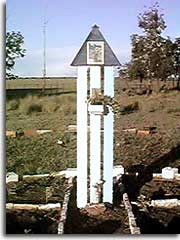 |
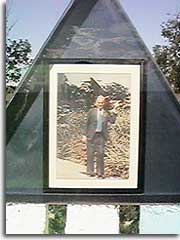 |
|
Ermita dedicada
a Don Joao, Paso Mayor, Bahía Blanca, Argentina Wayside shrine dedicated
to Joao Pozzobon, Paso Mayor, Baia Blanca, Argentina |
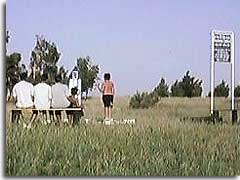 |
| In November
2000, in the year of the 50th anniversary of the Schoenstatt Rosary
Campaign, this wayside shrine was dedicated Das Bildstöckchen wurde im Jahr des goldenen Jubiläums der Kampagne der Pilgernden Gottesmutter eingeweiht |
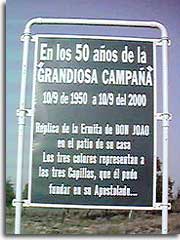 |
| A sign explains
the meaning of the wayside shrine in Paso Mayor, a replica of that
in the patio of Joao Pozzobons's house in Santa Maria, Brazil Ein Schild erklärt die Bedeutung dieses Bildstöckchens im Hof von Joao Pozzobons Haus in Santa Maria, Brasilien |
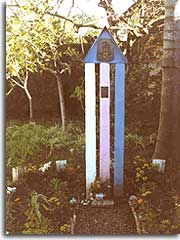 |
| Wayside shrine
by Joao Pozzobon's house in Santa Maria, Brazil - the three colors
symbolizing the three graces from the shrine Bildstöckchen von Joao Pozzobon im Hof seines Hauses in Santa Maria; die drei Farben stehen für die drei Wallfahrtsgnaden vom Heiligtum |
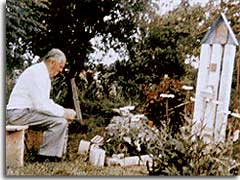 |
| Joao Pozzobon
praying by the wayside shrine in Santa Maria Joao Pozzobon beim Bildstöckchen in Santa Maria |
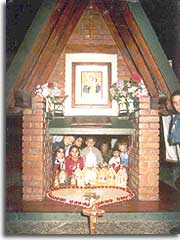 |
| Wayside shrine
in Corrientes, Argentina - one of more than 800 in the country Bildstöckchen in Corrientes, Argentinien - eins von mehr als 800 im Land |
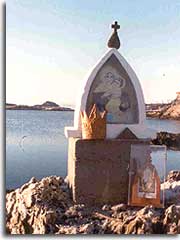 |
| Wayside shrine
in Lapataia, Tierra de Fuego Bildstöckchen in Lapataia, Feuerland, Argentinien |
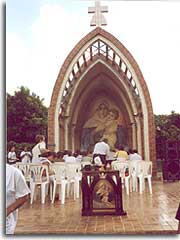 |
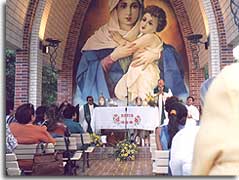 |
| The probably
largesst "wayside shrine" is in Santa Cruz de la Sierra, Bolivia Ermita - "kleine Kapelle": mit 18 Metern Höhe wohl die größte der Welt, in Santa Cruz de la Sierra, Bolivien |
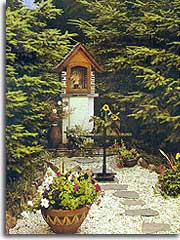 |
| Wayside Shrine
in Alf, Moselle - one of the many Schoenstatt wayside shrines in Germany
Bildstöckchen in Alf, Mosel - eines der vielen Schönstatt-Bildstöckchen in Deutschland |
| Foto: Badano, Campana Argentina © 2001 |
(Monina Badano, mkf) On March 21, during the Wednesday Audience at St. Peter's Square, Pope John Paul II proclaimed Mary as "star of the Third Millennium." She, the "Pilgrim of Faith," is to lead the people of the Third Millennium homeward to the Triune God. "Mary is the leading star," said João Pozzobon in 1980. Obviously and effectively, in 1950 the Mother Thrice Admirable of Schoenstatt led João Pozzobon, the "small student of Father Kentenich," a simple man from Brazil, to help her set out from the Shrine as Pilgrim Mother. Fifty years later, this "Schoenstatt Rosary Campaign of the Pilgrim Mother" is present in over 80 countries on all continents, with several million people involved. In gratitude, the members of the Campaign in Paso Mayor, Bahía Blanca, love to visit a recently erected wayside Shrine dedicated to João Pozzobon, a replica of the wayside Shrine on the patio of his house in Santa Maria.
The wayside Shrine dedicated to Don João was blessed in November 2000, in the year of the 50th anniversary of the Campaign and in the month of the International Meeting of the Campaign in Santa Maria, Brazil. "In September and October, we had several (in)opportune rainfalls that hindered us from erecting the wayside Shrine earlier," shared Father Daniel Jany, a Federation priest, co-ordinator of the Movement in Bahía Blanca. The "model" of this wayside is the one that João Pozzobon had erected by his house. Each morning when he left for Holy Mass in the Tabor Shrine, he prayed three "Hail Marys" by this wayside Shrine, asking for the graces from the Shrine. He also attached a brass tablet with the inscription:
"When you walk by, I am waiting for your glance;
nothing will withhold you if your heart knows how to love."
A sign explains the meaning of the wayside Shrine in Paso Mayor. The three colors of the wayside Shrine, it says, stand for the three small chapels -Blue, Pink and White- fruit of João Pozzobon's apostolic work.
The Three Small Chapels Built by João Pozzobon
The wayside Shrine of João Pozzobon has three pillars with three different colors: pink, blue, and white, representing the three small chapels that he built: the Blue Chapel, the White, the Pink.
The Blue Chapel symbolizes the grace of having a home because it aids poor families.
The "Chapel of Love," the pink one, symbolizes the grace of fruitfulness because it constitutes a Catechisis Center, led by Schoenstatt Sisters of Mary.
The White Chapel symbolizes the grace of transformation – in view of the pilgrimages that transform the heart.
The Wayside Shrines – fruit of an inspiration from Schoenstatt and Germany
The wayside shrines in the Campaign are the fruit of an inspiration that João Pozzobon got on his visit to Original Schoenstatt. On his return from his trip to Schoenstatt in 1979, he began to work for wayside shrines. The erection of wayside shrines and small chapels was something very popular in the south of Germany at the time in that the Marian devotion flourished. One finds them everywhere. Undoubtedly all strong spiritual currents tend to be expressed in sensitive signs.
Repeatedly, Father Kentenich, especially 1965 -1968, referred to exactly this phenomenon of the wayside Shrines and their meaning as expression of faith and means to support faith and by this constant reminder of the supernatural.
After a trip through Southern Germany in 1967, he mentioned that times would come when religious signs like these wayside Shrines would more and more disappear, encouraging the Schoenstatt members to be living signs of the reality of the Divine, supported by the replica Shrines and the home shrines, and to create places and times of a strong religious atmosphere. Mary, he said, would be the one to open hearts for God; therefore, the ultimate goal would be to give her the possibility to work.
The wayside Shrines according to João Pozzobon: Living Places of Attachment to the Shrines
After his return from Schoenstatt, João Pozzobon began to work for the erection of wayside shrines:
"... the novelty is that at the boundaries of the parishes and of the chapels, in the places that the priest does not reach out to, I am placing a sign that facilitates the meeting of the communities. The parish priests have given all their support and blessing for the placement of wayside Shrines of the Mother of God, the Mother and Queen, because there in Schoenstatt, in Germany, I saw many of these. I already go to the sixth wayside Shrine. It is something simple, but attractive. The people come, even when some do not like to see that; then the Mother takes charge of the rest."
The wayside shrines were very simple – the picture of the Mother Thrice Admirable, Queen and Victress of Schoenstatt, in brass, fastened to a wooden pole stuck in the ground, and on the image, a small foil roof. They were first blessed in the Shrine, with a second blessing following at the place where they were erected. On this occasion a procession with the neighbors, a talk and a dedication prayer took place. The program at the wayside Shrine was as follows: on Saturdays, prayer of the rosary. On first Fridays of the month, prayer of the Stations of the Cross. And, if it was possible, once a year, celebration of Holy Mass. Don João also recommended that the people meet next to the wayside Shrine on the 18th of each month. "... they meet on the 18th , as a symbol of union with the Shrine. It is explained at the wayside Shrines so that the people understand; they understand and they take it as a commitment."
Hundreds of Wayside Shrines – sign of the closeness of the Blessed Mother
During this time in which the erosion of faith is taking away any religious signs from every day life, the wayside shrines arise as small oases around which the simple people feel their Mother's closeness more concretely. Through the wayside shrines, the stream of grace can flow from the Shrine to the most remote corners.
The Campaign continued with this tradition, and today there are thousands of wayside shrines erected in the countries where it is present. The form, design and size of the wayside Shrines vary from place to place. Probably the biggest is the one that is in Santa Cruz de la Sierra, Bolivia. It has
the form of an image of the Pilgrim Mother and measures 18 m (appr. 60 feet) high. The image of the MTA is a famous local painter's work.
At the present time in Argentina there are approximately 800 wayside shrines, most of them located hundreds of kilometers from the nearest Shrine. They cover the country from North to South and from East to West: from Formosa to Tierra del Fuego, and from Mendoza to Corrientes. The county of Córdoba has about 120 wayside shrines.
Chile also is known for the large quantity of wayside shrines that are located throughout the entire country.
The popular wayside shrines in Germany that inspired Joao Pozzobon were also an inspiration to Schoenstatt members. Long before World War II, many of them began to erect wayside shrines or small chapels with MTA pictures in towns and villages where Schoenstatt grew, specially following Father Kentenich's initiative in 1934, when he encouraged the spread of MTA pictures. Many of these wayside shrines are part of the religious setting of many parishes, accepted and visited also by persons who don't know the Movement. When the Pilgrim Mother reaches a "new" town in Germany, people often know the image already from a wayside shrine. Inge Cleven, a young professional woman from Northern Germany, often visits the wayside Shrine in a forest area near Kleve, her home town, with her group, especially in May and October. "On my last visit I met a man who brought flowers. He does not belong to Schoenstatt, and he is not the only one to do so. The Blessed Mother is working from here!"
Contributing: P. Daniel Jany; Material taken from: 140.000 km caminando con la Virgen, y Héroe hoy, no mañana, Fr. Esteban Uriburu